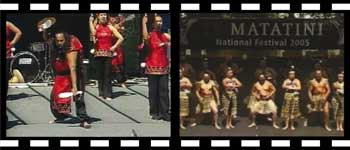|
||||||||||
|
||||||||
| Questions/instructions: He mahi rorohiko tënei. Ka mätakitaki täua i ëtahi röpü kanikani e toru. Whakaaturia te käri pätai Kanikani, ka pänui ai i ngä pätai. Kätahi ka päwhiri anö i te pütohu Kanikani, ka mätakitaki anö i ngä röpü kanikani.
|
||||||||
| %
responses |
||||||||
| 1. E möhio ana koe ko wai ngä iwi o ngä röpü kanikani? | ||||||||
| Tongan: |
correctly dentified group as Tongan |
2 |
||||||
identified group as Pacific Island |
73 |
|||||||
| Kapa haka Mäori: |
correctly identified |
84 |
||||||
| Australian Aboriginal: |
correctly identified |
41 |
||||||
| 2. Körerotia mai kia toru ngä tino ähuatanga o ia röpü. | ||||||||
| Tongan:
|
Mentioned: |
3 valid things about group |
15 |
|||||
1 – 2 valid things about group |
61 |
|||||||
| Kapa
haka Mäori:
|
Mentioned: |
3 valid things about group |
20 |
|||||
1 – 2 valid things about group |
57 |
|||||||
| Australian
Aboriginal:
|
Mentioned: |
3 valid things about group |
13 |
|||||
1 – 2 valid things about group |
63 |
|||||||
| 3. He aha ëtahi ähuatanga örite o ngä röpü e toru nei? | ||||||||
recognised 3 valid similarities |
26 |
|||||||
recognised 1 – 2 valid similarities |
46 |
|||||||
| 4. He aha ëtahi ähuatanga rerekë o ngä röpü e toru nei? | ||||||||
recognised 3 valid differences |
35 |
|||||||
recognised 1 – 2 valid differences |
50 |
|||||||
| 5. He aha i rerekë ai te ähua o ngä kanikani a ngä röpü e toru nei? | ||||||||
good explanation |
24 |
|||||||
some explanation |
63 |
|||||||
6. Körerotia mai kia toru ngä tino ähuatanga o ia kapa haka. |
||||||||
| Contemporary Kapa haka: |
recognised 3 valid things about contemporary kapa haka |
30 |
||||||
recognised 1 – 2 valid things about contemporary kapa haka |
57 |
|||||||
| Traditional Kapa haka: |
recognised 3 valid things about traditional kapa haka |
30 |
||||||
recognised 1 – 2 valid things about traditional kapa haka |
50 |
|||||||
| 7. He aha ëtahi ähuatanga örite o ngä kapa haka e rua nei? | ||||||||
recognised 3 valid similarities |
41 |
|||||||
recognised 1 – 2 valid similarities |
48 |
|||||||
| 8. He aha ëtahi ähuatanga rerekë o ngä kapa haka e rua nei? | ||||||||
recognised 3 valid differences |
49 |
|||||||
recognised 1 – 2 valid differences |
40 |
|||||||
| 9. He aha i rerekë ai te ähua o ngä kapa haka e rua nei? | ||||||||
good explanation (e.g. influence of other cultures, technology) |
31 |
|||||||
some explanation |
47 |
|||||||
| 10. Ko tëhea te röpü e tino pai ana ki a koe? He aha ai? | ||||||||
gave good justification of opinion |
20 |
|||||||
gave some justification of opinion |
73 |
|||||||
Commentary: |
||||||||

